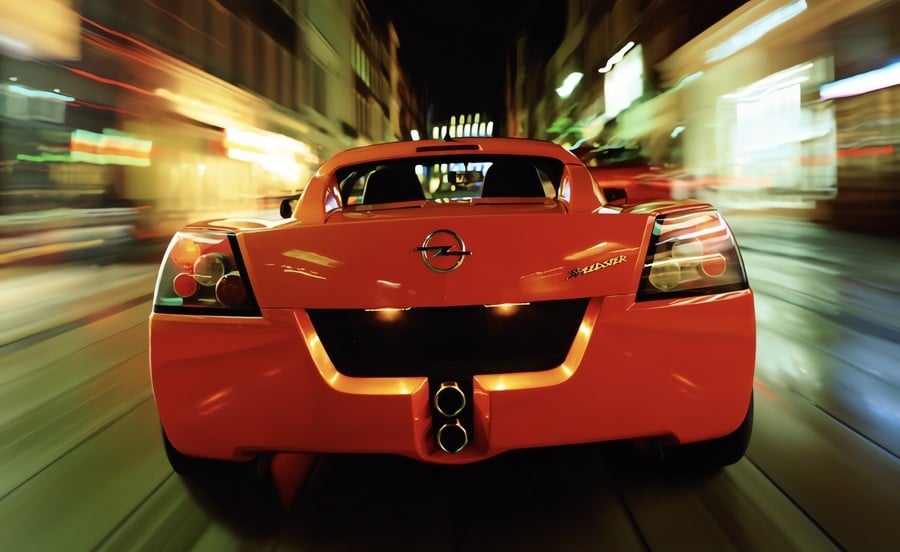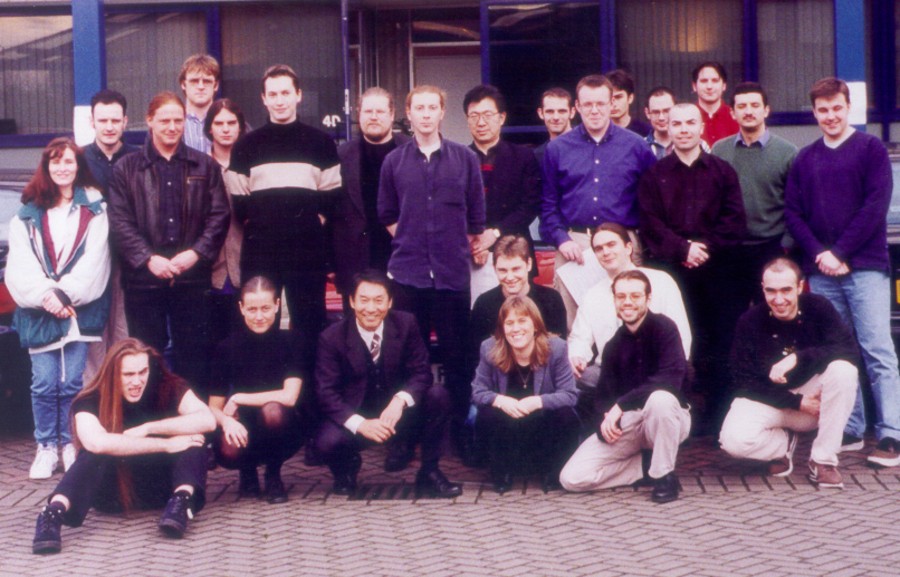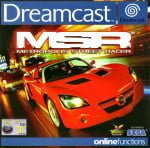
Sometimes, a change of pace can be a good thing – and that was certainly the case for Martyn Chudley, founder of Raising Hell Software. Responsible for Combat Crazy, The Killing Game Show / Fatal Rewind and Wiz 'n' Liz, the small studio would eventually morph into Bizzare Creations before taking on what would be, at that moment in time, its largest project to date: the official Formula 1 game for Sony's all-conquering PlayStation console. Chudley and his team had exchanged 2D platforming action for realistic 3D racing, charting the course of the rechristened outfit for the next decade or so.
Rumour has it that people at Sega were impressed when they saw a demonstration of our first F1 game on the PlayStation at some event or other
It was the aforementioned F1 game – distributed by Sony subsidiary Psygnosis, which had also handled publishing duties for all of Chudley's titles up to this point – that led to Bizarre Creations falling into the orbit of Sony's rival Sega. However, the means by which Katsuhisa 'Kats' Sato – who had worked at Sega of Japan before relocating to Sega Europe to act as a Senior Producer – tracked down the team was far from orthodox. "Rumour has it that people at Sega were impressed when they saw a demonstration of our first F1 game on the PlayStation at some event," Chudley tells us. "As Sony was keeping the developers quiet, Kats apparently used his initiative, 'crashed' the game by hitting the reset button and waited for it to be restarted, revealing who we were."
Sega was, around this time, already exploring technology for its Saturn successor, which would eventually become the Dreamcast. Chudley was duly summoned to Sega's European HQ by its boss, Kazutoshi Miyake – who had a reputation within the industry for being somewhat intimidating – and found himself in the company of several other notable figures. "I think Yuji Naka was there, as well as Naohiko Hoshino and a couple of developers, including Alex Ward from Criterion. We were all discussing the potential of the upcoming Sega Dural/Katana console, which would be in direct competition with Sony's PlayStation 2. Outwardly, Miyake-san was definitely intimidating – with a reputation only enhanced by his prowess at martial arts – but with us, he was nothing other than the perfect gentleman."

It's tempting to ask at this stage why Chudley and his team would risk a highly profitable relationship with Sony to throw in their lot with Sega, the firm which had been badly blooded by its failure in the 32-bit war. It turns out that Sony wasn't being entirely honest with the studio. "Coming into late 1997, we had just finished two extremely hard years, completing both F1 and F1 97," he explains.
This was the last straw; we didn't want to be just a studio to grind out the same product year after year, and the lack of respect regarding the situation with the licencing was the end of F1 – and Sony – for us
"The latter was done in parallel with the actual season taking place, so we were building circuits and cars that hadn't even been raced yet, as well as trying to stay completely up to date with all of the changes that had taken place during the season – drivers, liveries, sponsors, licencing and so on. We had heard via the grapevine that Sony didn't actually have the licence for the game – as was eventually proven by the game being withheld from sale and removed from stores. However, despite this, alongside the previous 12 months of us working ridiculous hours – sometimes up to 100 hours a week [and] pretty much living in the office – we had a meeting with Sony management who, to our faces, told us that this was not the case and the licence was all secured – and [that] they had pencilled us in to work on the next five seasons of F1. This was the last straw; we didn't want to be just a studio to grind out the same product year after year, and the lack of respect regarding the situation with the licencing was the end of F1 – and Sony – for us."
Sega, by contrast, made for a refreshing change as a development partner. "Sega were typically great to work with," continues Chudley. "We knew they wanted a game from us, but they didn't know what game! We had loads of meetings, at one point discussing the potential of the Ferrari Licence, as Sega already had a pre-existing relationship with them for their F355 Challenge game, and thoughts on a sort of Italian Job vibe where we just had Minis. However, between us all, we finally settled on a racing game where we would drive aspirational but 'affordable' sports cars. I had a Toyota MR2, Kats had a Fiat Coupe Turbo, his wife a Barchetta, and we had a few others around like Mazda MX-5s and MGFs around the office, so it all made sense." The seeds for what would eventually become Metropolis Street Racer had been sown.
Even at this stage, the Dreamcast hardware was very much in flux, and Bizarre Creations initially had little exposure to the console. A rumour that it would use Microsoft's OS as its development platform caused some early upset, given how highly Chudley and his team prided themselves on their collective coding abilities. "We had seen very little of the hardware, and in fact, I think they were still talking about having the Microsoft OS as a primary development platform – something we rebelled at! We had experience of not only PSX but PC programming, particularly for the new 'high-end' gaming graphics cards from 3DFX and Rendition, so we were pretty used to 'hitting the metal' directly to maximise performance. However, once it was established that the Dreamcast would be driven by the PowerVR chipset and we didn't have to go through Windows CE, it was somewhat of a relief!"
We did everything we could, even to the point of renting a car (a Mercedes SLK) and blowing its engine
Metropolis Street Racer is notable for using actual cars, a trend which had become increasingly popular during the '90s thanks to the likes of Need for Speed and Gran Turismo. As Chudley reveals, securing the necessary permissions for these vehicles wasn't as onerous as you might assume. "This was always Sega's department! However, as we knew the 'boundaries' of the game (no Ferraris, Lamborghinis or Porsches for us), all of the cars we wanted were pretty much got, presumably with the car manufacturers pleased to have their more affordable cars being represented in a 'cool' way."
Of course, rendering the cars in 3D is only one part of the equation; they needed to feel real, too. "We did everything we could, even to the point of renting a car (a Mercedes SLK) and blowing its engine on a Dyno," says Chudley with a laugh. "Apparently, the guys got it towed to a nearby lane and said it 'blew up'. However, we think Mercedes got the diagnostics out of it and spotted that the car had been red-lined in every gear, so they knew something was amiss! Internally we had created an all-singing-all-dancing editor and data-management application called MetGP, within which we put in all of the real car statistics, which fed into the game physics engine. The audio was a work of passion as well, driven by Jonathan (Amor) as audio truly defines the character of each car, as well as the music system, which was a unique, dynamic city-based radio system."
Given that it sought to celebrate real-world cars from a wide range of manufacturers, it made sense to Bizarre Creations that these vehicles would be hurtling around not fictional circuits and cities but actual places rooted in reality. This element of Metropolis Street Racer was quickly seized upon by the games press as the title's overriding hook, at least in the early days of media coverage – and this was something that Chudley had no issue with. "Very early on, we established that one of the USPs for the game would be real, affordable cars in real cities. This drew on our experience from creating the circuits from the two Formula 1 seasons, and also allowed our artists a lot more creative freedom – as well as some great research trips! Between them, they amassed tens of thousands of photos and countless hours of video."
The main issue we had with the first year of development is that there were a lot of – shall we say – 'differences of opinions' on the direction of the game
Despite this solid foundation, the early development of Metropolis Street Racer was anything but a smooth ride. "The main issue we had with the first year of development is that there were a lot of – shall we say – 'differences of opinions' on the direction of the game," recounts Chudley. "I personally had not coded after the original Formula 1 as I had handed the reins over to another lead-coder for F197. Sega was his passion, and it was a no-brainer to have him as the lead coder on Metropolis Street Racer. Up to this point, the game was still pretty much codenamed 'Project Crimson', a nod to the initial Ferrari ideas we had. However, over the following 12 months, it was pretty obvious to all that the project was not going in a direction anybody was happy with."
An early E3 demo had given Chudley and his team some food for thought, too. "one of the reviewers claimed that the cars handled like 'beds'. However, it wasn't just the handling; the whole vibe of the game was too over the top; we had a crazy over-stretched camera viewing frustum which distorted everything, and the late inclusion of hot air balloons and fighter jets just pushed the game down a direction that was way too 'arcadey' for us. Sega had their Arcade division – at Bizarre we wanted more, and for the game to be a lot more grounded in reality."
This disagreement regarding the project's direction ultimately led to it missing the western launch of the Dreamcast in 1999. "Pretty soon after the aforementioned scathing reviews of the E3 demo, we believe that the lead coder was 'wined-and-dined' by a major software developer and subsequently resigned," explains Chudley. "We were absolutely devastated – we had used pretty much the entire budget and time creating a demo that wasn't fit for anything. However, this actually turned out to be a blessing in disguise, albeit a hard one. Knowing that we had to do something drastic, we apologised profusely to Sega and explained that we wanted another 12 months to develop a worthy game, at our expense. Along with another ex-F1 coder, we decided that I needed to get back into leading the coding directly. The first things we did were to change the camera viewing angle and make some tweaks to the car handling, camera and dynamics. We also 'allowed' the artists a larger polygon budget from which to create the car models. As soon as we stuck this all together, it was obvious to us that we could create something worthy, and Sega agreed."
Knowing that we had to do something drastic, we apologised profusely to Sega and explained that we wanted another 12 months to develop a worthy game, at our expense
Needless to say, that additional year of development placed an intense strain on the finances of the studio. "We pretty much developed the last 12 months of the game on our own cash reserves, but we had to save face from the 'disaster' that was the first demo," Chudley reveals. "But we believed in it. But again, we were back to the 100-hour weeks. It was an extremely hard project to complete." To get Metropolis Street Racer over the finishing line, Chudley had to become more hands-on with development than before, and much of the original work was overhauled entirely – including the game engine.
"The engine, that was down to Roger (Perkins) along with our Technical Director Walter (Lynsdale)," he says. "I was controlling the structure, flow and gameplay elements, as well as 'steering' the game and team in the right direction – pretty much the same role I had on the original F1 game. From that point on, it was all about pushing the game into new areas; the various game modes, the inclusion of a real-time clock, the creation of the numerous circuits within the cities, the presentation... I think at one point, we counted 30 things that had never been in a racing game before."
One of the more unique aspects of Metropolis Street Racer was added during this period, and would go on to become the hallmark of a wider series of games by Bizarre Creations. "The Kudos system came very late on, about five months before completion, I think," remembers Chudley. "It happened as I was 'racing' a Fiesta XR2 in my MR2 onto the motorway coming out of Liverpool. The road climbs up over the roads below and sweeps around before becoming the M62. At this point, I was 'ahead', but I felt the back end of the car step out – it felt like it was sideways, but it was probably only a few degrees! But the only thing I could think of, rather than potentially of dying, was 'Wey Hey!' – I knew we had the 'point' of the game. It wasn't about going fast, it was all about doing cool stuff. In fact, 'Wey Hey!' became immortalised as one of the Kudos-earning exclamations within the game!"
Richard, whilst in the recording studio, got the vocalist to record a few, ahem, 'adult' lines about Jose and a part of his anatomy, and subsequently mixed it into a song
With the gameplay side of things finally starting to take shape, it was reassuring to Chudley and his team that the audio came together in a much smoother fashion – largely thanks to the involvement of the legendary composer Richard Jacques, who had previously worked on the likes of Sonic R, Shinobi X and Sonic 3D Blast for Sega. "Richard was (and still is) amazing," gushes Chudley. "He and Jonathan (Amor) just knew exactly what the game needed and really delivered. Obviously, the attention to detail of the radio stations and the vast variety of the music was astounding, but the stand-out thing for us didn't actually make it into the final game! We had an amazing vocalist on one of the tracks (sadly, I don't remember her name). Also on the project, we had an Associate Producer (Jose Aller) who worked alongside Kats. Richard, whilst in the recording studio, got the vocalist to record a few, ahem, 'adult' lines about Jose and a part of his anatomy, and subsequently mixed it into a song. Suffice it to say, this song never saw the light of day!"
Getting Metropolis Street Racer out of the garage and onto the track brought back many unwelcome memories to Chudley and his team, who, lest we forget, assumed they had left the prospect of 100-hour weeks behind them when they'd backed away from Sony's F1 series. "The final day and weeks were brutal – we were just living in the office, and gallows humour was the order of the day to see us through," recalls Chudley. "I clearly remember one day hearing Walter giggling like a schoolgirl – he had rigged up the car horn to sound whenever an AI car crashed (which was quite often), and the lack of sleep made this the funniest thing ever. This was obviously something else that didn't make the final game! And at one point, we'd just started looking at testing the 'final' game when somebody spotted that there was no music within the game's front end. After a lot of panicking and asking around, we finally established that Phil (Snape) – tools and effects coder on the game – had decided that the music was 'annoying him', so he'd just disabled it."
Despite the setbacks and the strenuous working hours, Bizarre Creations finally shipped Metropolis Street Racer in October 2000. However, due to the incredible scope of the title, it unfortunately shipped with its fair share of bugs. "We were doing so many things that had never been done before, and we were completely burnt out," offers Chudley by way of explanation.
To quote Sega's Lead Tester on the morning we handed over the final GD disk for duplication: 'this game is just too big to test'.
"To quote Sega's Lead Tester on the morning we handed over the final GD disk for duplication: 'this game is just too big to test'. The pressure we were under to release the game, the size of the game, the fact we were burnt out and the huge amount of innovation in the game, sadly, all contributed to this. We fixed as much as we could, but towards the end, we were told to prioritise certain bugs to fix over others. I was 'allowed' to have something like five bugs a day that I could fix if I, as the Creative Director, felt it was important to the game, but sadly there was a lot that just got 'blown off' by the powers-that-be."
Given the somewhat fraught nature of its development, it should come as no great shock to learn that there were features missing in the final game that players picked up on – the most notable of which was online play, a crucial part of Sega's sales pitch for the Dreamcast. "We had experience of link-up play on Formula 1 on the PlayStation and knew it was a real problem, for what would have then been limited gain," explains Chudley. "Remember then that gaming was still pretty much a solitary affair; something we managed to put right with its introduction into the Project Gotham Racing series – but even that was the second game, not the original. The infrastructure for online gaming just wasn't there, with 'online' gaming pretty much confined to LAN, and predominantly on PC, not consoles – and that was how it was, pretty much until the introduction of Xbox Live."
Another omission was the lack of a full replay mode, preventing players from looking back at their on-track performances at their leisure. Chudley admits he is as puzzled as anyone else as to why this wasn't included. "I've no idea! Looking back, I would guess it would be a combination of memory usage, the setup of all of the cameras and the potential for the creation of a lot of bugs, all for a system that wasn't essential to the overall gameplay."
We spoke with Sega about the possibility of us doing a SKU of Metropolis Street Racer for the PlayStation 2, as we knew that Sega was planning on becoming a game publishing organisation and dropping out of the hardware business
After years of development and more than a few sleepless nights along the way, Metropolis Street Racer eventually made it to market and was met with positive reviews but unimpressive sales; approximately 120,000 units were sold worldwide, with over 100,000 of those being retailed in North America. "Towards the end, we could see that the writing was on the wall for Dreamcast," laments Chudley. "We spoke with Sega about the possibility of us doing a SKU of Metropolis Street Racer for the PlayStation 2, as we knew that Sega was planning on becoming a game publishing organisation and dropping out of the hardware business. However, in the meeting, Sega were adamant that they would remain in the hardware business and that a PS2 version was simply 'not an option'. At this point, we had sunk a year's worth of development costs (as well as more man-hours and heartache that we could care to mention), and we could see that we would never recoup anything like that investment given the 'lateness' of the game and the upcoming demise of Dreamcast as a platform." Just three months after the game launched in November 2000, Sega officially pulled out of the hardware business.
Thankfully, there was a positive resolution to this situation. "As sad as it was to leave them, our contract with Sega allowed us to retain all of the rights for the game, with the exception of the name/trademark and the licenced content," says Chudley. "Luckily for us at this point, Microsoft were looking for partners as they were planning on their new Xbox console. We pitched them a game that was pretty much a cross between Formula One and MSR – ie, F1 cars in real cities. We presented this to them, alongside a pre-release demo of MSR. They said, 'it's a nice pitch, and all, but what about that?' pointing at MSR. 'Could we have a version of that'? And the rest, as they say, is history."
Bizarre Creations had therefore moved from Sony to Sega and now to Microsoft, and found the Redmond-based tech giant to be a totally different proposition compared to what had gone before. "With Sega, it was like the wild-west compared with Microsoft. On MSR, we just got on with it, loads of passion and energy, just doing what we felt was right. With Microsoft, it was all about systems, and structure and focus groups – they respected us as developers, and we respected the guys and gals we worked directly with, but there was so much going behind the scenes."

There was no question of this new venture missing its deadline. "Project Gotham Racing was to be a launch title, and it had to be right and on time... no excuses!" laughs Chudley. "I think this is when we 'grew up' most – we definitely lost something – it became a lot more serious, but we could still (even up to PGR4) put a lot of creativity and innovation into the games. However, it always felt that there was this huge behemoth alongside us – we always still felt they were our games, but it all just became a little sterile."
As well as creating four commercially and critically acclaimed entries in the Project Gotham Racing franchise, Bizarre Creations would also release the likes of Geometry Wars, The Club and Blur, the latter of which was a fusion of real-world racing with Mario Kart-style weapons that garnered amazing reviews but failed to find a sizable audience. In September 2007, Activision purchased Bizarre Creations, with James Bond 007: Blood Stone – a title which sold poorly and received mixed reviews – being the studio's final game before it was closed. It was a sad end to a company which, for well over a decade, was the go-to outfit when it came to crafting thrilling racing experiences.
Huge thanks to Ami Langton for her invaluable assistance in the creation of this feature.

